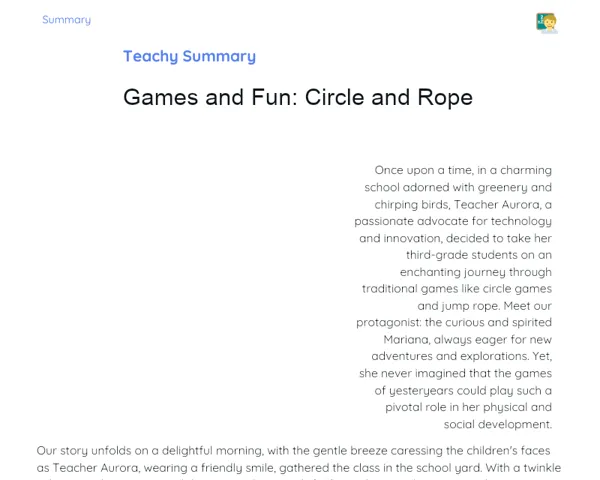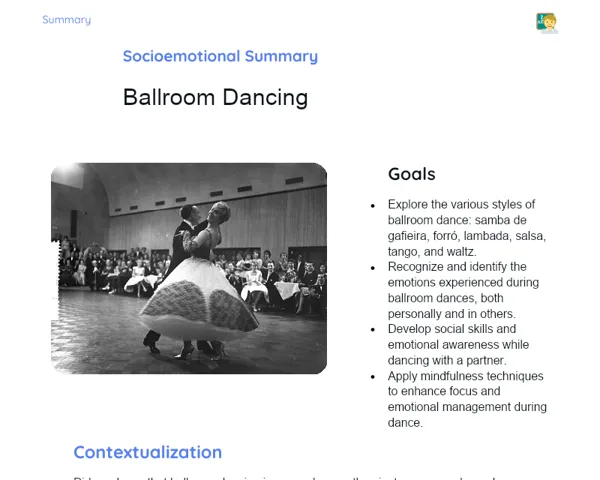Summary Tradisional | History of Sports
Contextualization
Sports have been an integral part of human history, deeply embedded in our culture and society, influencing and reflecting various aspects across different eras. Originating in Ancient Greece with the first Olympic Games in 776 BC, sports transcended mere physical activities; they were religious and cultural festivities that brought people together under a shared ethos. Participation in sports not only encouraged physical fitness but also fostered the spirit of competition and devotion towards the gods, particularly Zeus.
As centuries passed, sports evolved in response to changing social and cultural landscapes. Ancient Rome saw a more extravagant and brutal form of sports, characterized by gladiatorial contests in majestic arenas like the Colosseum. The Middle Ages presented a period of decline under the dominion of the Catholic Church, though tournaments and jousts flourished among the nobility. It was during the Renaissance that sports experienced a revival, reflecting the classic ideals of bodily and mental prowess. The modern era commenced with the reestablishment of the Olympic Games in 1896, heralding an age of global engagement and professional advancement in sports.
To Remember!
Ancient Greece and the First Olympic Games
Ancient Greece is often seen as the birthplace of organized sports, with the inaugural Olympic Games taking place in 776 BC. These events were more than just competitions; they were religious observances honouring Zeus, held every four years in Olympia. Beyond encouraging health and physical fitness, the Olympic Games created a sense of unity among the Greeks, engendering a collective identity and national pride. Traditional events included running, jumping, throwing, wrestling, and chariot racing, with victors enjoying immense respect and laurels.
The Olympic Games bore a sacred essence, marked by rituals and festivals dedicated to the gods. Only freeborn Greek men were allowed to compete, while women were completely barred from participating or even spectating. Physical excellence and honour were paramount, with athletes engaging in rigorous training to bring victory and glory to their city-states.
A notable tradition was the Olympic truce, a ceasefire between warring city-states that ensured safe passage for athletes and spectators to Olympia. This truce signified peace and camaraderie among the Greeks, even in turbulent times, lasting for about 12 centuries until its termination by Roman Emperor Theodosius I in the late 4th century AD.
-
First Olympic Games held in 776 BC.
-
Religious celebrations in honour of Zeus.
-
Events: running, jumping, throwing, wrestling, and chariot racing.
-
Olympic truce symbolizing peace and unity.
Ancient Rome and Athletic Spectacles
In Ancient Rome, sports evolved into grand and often brutal spectacles that mirrored the entertainment culture and social hierarchy of Roman society. Romans adopted and modified numerous Greek sports into opulent public displays held in amphitheatres like the Colosseum. Popular competitions included gladiatorial battles, chariot races, and contests with wild animals, captivating the masses while showcasing the power and generosity of the emperors.
Gladiators, frequently slaves, war captives, or criminals, were prepared to fight to the death, creating a blood-soaked entertainment form that fascinated Roman audiences. These contests illustrated the valor and prowess of the gladiators; victors could earn freedom and become celebrated figures among the populace. Chariot racing was equally prominent, with racers navigating treacherous high-speed tracks, arousing frenzy and considerable betting among the spectators.
Beyond fighting and racing, Romans engaged in other athletic activities, including wrestling, boxing, and throwing discus and javelins, albeit with less fanfare. Sports events in Ancient Rome provided entertainment and acted as social control, offering the populace respite from their daily struggles while reinforcing state authority.
-
Sports evolved into grand public spectacles.
-
Gladiator fights, chariot races, and battles with wild animals.
-
Gladiators as slaves, war captives, or convicts.
-
Sports as a means of social control and power demonstration.
The Middle Ages and Temporary Decline of Sports
The Middle Ages saw a decline in sports, largely influenced by the Catholic Church's perception of physical activities as sinful or contrary to Christian principles. Sporting pursuits were sidelined, and many popular games and competitions from antiquity faded away. Nonetheless, some athletic practices endured, especially among the aristocracy.
Jousting and tournaments thrived among medieval knights, who battled in simulated combat to showcase their skills and bravery. These competitions were festive occasions combining entertainment with military training, with knights donning armor and wielding lances. These events could be perilous, frequently resulting in serious injuries or fatalities.
Alongside jousting, hunting and various ball games were also common in the Middle Ages, albeit on a lesser scale. Hunting was particularly significant for the elite, serving both as a food source and a means to sharpen combat skills and endurance. Variants of ball games laid the foundation for modern sports like football and rugby.
-
Decline of sports attributed to the Catholic Church's influence.
-
Jousting and tournaments remained popular among nobles.
-
Various physical activities like hunting and ball games.
-
Sports as military training and demonstration of prowess.
Renaissance and the Revitalization of Sports
The Renaissance, marked by a resurgence of interest in classical Greek and Roman values, rejuvenated sports with a fresh focus on both body and mind. Inspired by classical thinkers, Renaissance scholars advocated for physical education as a key component of human growth, linking engagement in sports to health, well-being, and the development of virtuous, well-rounded individuals.
During this period, many previously neglected sports re-emerged, and new disciplines began to capture public interest. Fencing evolved into a precise art form and a crucial skill for nobles and knights, who engaged in sword duels for prestige and honour. Ball games, including early versions resembling modern football and tennis, became communal activities enjoyed by both the aristocracy and the common folk, fostering social interaction and healthy competition.
The Renaissance also gave birth to gymnastic academies and sports clubs, where individuals gathered to hone their physical abilities. These institutions fostered the spreading of Renaissance principles of harmony between body and mind, leading to the establishment of a vibrant sports culture that prioritised athletic excellence and competitive spirit. The influence of this era continues to resonate in the prominence of sports in education and daily life today.
-
Rediscovery of classical ideals highlighting body and mind.
-
Revitalization of sports such as fencing and ball games.
-
Emergence of gymnastic academies and sports clubs.
-
Role of physical education in human development.
Key Terms
-
History of Sport: Study of the origins and evolution of sports over time.
-
Ancient Greece: Cradle of the first Olympic Games and organized sports.
-
Olympic Games: Athletic events held every four years in honour of Zeus.
-
Ancient Rome: Culture of public spectacles and brutal sports like gladiatorial combats.
-
Middle Ages: A period noted for the decline of sports due to the Catholic Church's influence.
-
Renaissance: A revival of sports with a focus on the importance of body and mind.
-
Modern Era: The rebirth of the modern Olympic Games in 1896.
-
20th and 21st Centuries: The rise of professionalisation, globalisation, and technology's impact on sports.
Important Conclusions
The journey through the history of sports reveals a rich tapestry, from Ancient Greece to the modern era. The inaugural Olympic Games of 776 BC were not mere athletic contests but religious festivities that unified communities around shared values. Ancient Rome transformed sports into extravagant spectacles, often brutal, mirroring their societal structure. While the Middle Ages witnessed a stagnation in sports due to the Catholic Church's sway, the Renaissance rekindled the appreciation of physicality alongside intellect.
With the dawn of the modern age, sports experienced unparalleled globalisation and professionalisation. The resurgence of the Olympic Games in 1896 was a watershed moment, paving the way for the formation of sports federations and the global spread of sporting events. In recent centuries, sports continue to adapt, driven by technological advancements, increasing inclusivity, and the professionalisation of athletes. These shifts have not only altered the practice of sports but have also changed societal perceptions surrounding them.
Examining sports history is vital to understanding how these activities both reflect and influence cultures and communities over time. It enhances our appreciation for the evolution of sports and emphasises their role as significant cultural and social phenomena. By delving deeper into this subject, students can develop a clearer comprehension of how sports shape identities and values, both historically and in contemporary society.
Study Tips
-
Review classroom materials, such as presentations and illustrative videos, to strengthen understanding of key concepts.
-
Read additional literature and references on sports history for a broader perspective.
-
Participate in group discussions or online forums about the evolution of sports, sharing insights and learning collaboratively.



